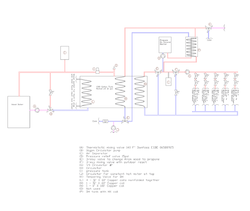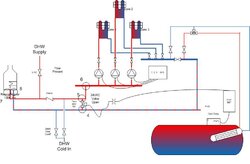Hello all,
First let me say that like a lot of others I wish that I had found this forum a year ago.
I have been reading a great deal here for the past couple weeks.
I am running out of time. I need to start installing the system so that I can move in.
I have already purchased the wood boiler and craned it into the room. The SS tank is in place. Most of the non O2 barrier radiant tubing has been set but I have not hooked up the manifolds (yes I know I should have used O2 barrier pipe but what is done is done).
I have had the heat load for the house calculated at 66K BTU.
I want to use the wood as the primary heat but be able to switch to propane if I leave and to heat the DH during the summer.
In the future I will be adding a 8K gallon swimming pool, hot tub, 8 solar HW panels, 1200 sq' shop 120' from house.
I live 4 miles from the grid and so I rely on Solar photovoltaic. I have to be very conscious of my power usage but should have enough.
I transport my domestic water and will store it in a 2K gallon cistern.
I am planning on building my own controller.
I think that covers the basics.
I have included a drawing I would love some input on.
I realize that a primary/secondary system provides more control but I worry about the extra power needed for the additional pumps.
Thanks
Erik
First let me say that like a lot of others I wish that I had found this forum a year ago.
I have been reading a great deal here for the past couple weeks.
I am running out of time. I need to start installing the system so that I can move in.
I have already purchased the wood boiler and craned it into the room. The SS tank is in place. Most of the non O2 barrier radiant tubing has been set but I have not hooked up the manifolds (yes I know I should have used O2 barrier pipe but what is done is done).
I have had the heat load for the house calculated at 66K BTU.
I want to use the wood as the primary heat but be able to switch to propane if I leave and to heat the DH during the summer.
In the future I will be adding a 8K gallon swimming pool, hot tub, 8 solar HW panels, 1200 sq' shop 120' from house.
I live 4 miles from the grid and so I rely on Solar photovoltaic. I have to be very conscious of my power usage but should have enough.
I transport my domestic water and will store it in a 2K gallon cistern.
I am planning on building my own controller.
I think that covers the basics.
I have included a drawing I would love some input on.
I realize that a primary/secondary system provides more control but I worry about the extra power needed for the additional pumps.
Thanks
Erik




